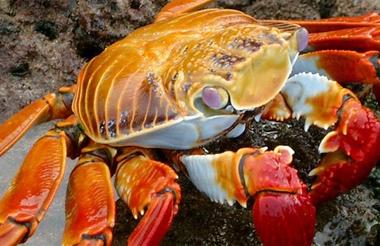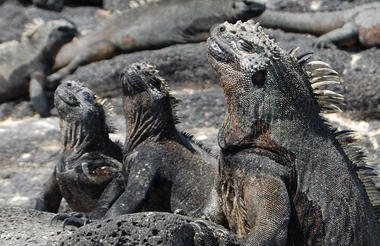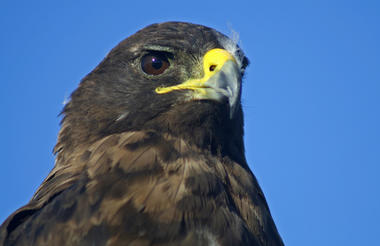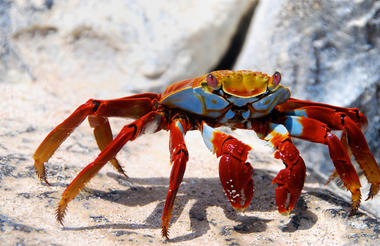After landing on Santa Cruz, you will go through an inspection point designed to prevent the introduction of foreign plants and animals. Your guide will meet you at the airport, assist with your luggage, and take you to the bus for the ferry across the Itabaca Channel. You will then visit Ranch Manzanillo or a similar farm in the highlands of Santa Cruz Island. Be sure to wear comfortable shoes, light clothing, and bring a waterproof jacket, sunblock, camera, and insect repellent.
You will enjoy a picnic lunch and a short walk before boarding the Motor Catamaran. Meanwhile, your luggage will be transferred directly to the Seaman Journey yacht.
At Santa Cruz, you will observe wild Galápagos tortoises and explore lava tubes, sinkholes, and craters in the highlands. After this visit, you will continue your journey by boarding the M/C Seaman Journey.



AM: MORENO POINT, ISABELA ISLAND
You will explore Punta Moreno, located on Isabela Island’s west coast at the entrance of the Bolivar Channel. The trail follows a Pahoehoe lava flow leading into coastal lagoons. Along the way, you will spot various bird species, including blue-footed boobies and flightless cormorants, near the lakes and mangroves.
PM: FERNANDINA ISLAND, MANGLE POINT
You will visit Mangle Point, off Fernandina’s eastern coast, known as an excellent snorkeling site. You will ride in a panga or zodiac through mangrove groves, where you may encounter sea lions, tortoises, pelicans, rays, and numerous seabirds.



Mangle Point
Breakfast
Lunch
Dinner
AM: ISABELA ISLAND, URBINA BAY
You will visit Urbina Bay, located at the base of Alcedo Volcano on Isabela’s west coast. This area was uplifted in 1954, stranding marine life and creating excellent snorkeling opportunities. You will explore a 3,200-meter trail that winds through sand, pumice, lava, coral, and coastal vegetation.
Along the way, you will look for iguana burrows and may swim alongside penguins while snorkeling, with chances to observe red and blue lobsters. You might also see Darwin’s finches and larger land iguanas, as well as giant tortoises roaming the area. The unique vegetation includes chamomile, rosewood, and Darwin’s cotton flowers, all endemic to the Galápagos.
PM: ISABELA ISLAND, TAGUS COVE
You will explore Tagus Cove, west of Darwin Volcano, once a favorite spot for pirates and whalers. Here, you will see pirate graffiti and a cave with inscriptions dating back to the 1800s. The area is known for its volcanic rocks, including “lapilli,” small spherical stones.
You will take a moderately challenging trail leading to a lookout above Darwin Lake and the bay below, where you can spot finches and mockingbirds.
Tagus Cove is also an excellent spot for snorkeling and sea kayaking. You will have the chance to observe a colony of flightless cormorants.



Breakfast
Lunch
Dinner
AM: FERNANDINA ISLAND, ESPINOZA POINT
You will visit Espinoza Point, famous for its marine iguana colonies that look like armies covering entire areas. You will also encounter unique species such as the flightless cormorant, Galápagos penguin, Galápagos hawk, and Galápagos snake. This is one of the most pristine and remote areas of the Galápagos archipelago.
PM: VICENTE ROCA POINT
You will explore Vicente Roca Point on Isabela’s northwestern coast, where high cliffs and impressive lava formations shape the landscape. This bay is rich in marine life, and you will look for seahorses, sea turtles, and the elusive Mola-mola (sunfish).
Enjoy panga rides and snorkeling as you observe penguins, blue-footed boobies, terns, and playful sea lions.



Breakfast
Lunch
Dinner
AM: SANTIAGO ISLAND, ESPUMILLA BEACH
You will explore Espumilla Beach, located on Santiago Island’s northern coast within James Bay. This picturesque coastline showcases erosion and unique formations shaped by the sea. You will wander through the palo santo forest and mangroves, and may spot nesting baby sea turtles in the sand dunes as well as a flamingo colony in the coastal lagoon.
You will notice how the vegetation changes dramatically over short distances—from dry to humid areas—and see evidence of the impact introduced species like feral goats had before they were eradicated. Wildlife here includes sea lions and fur seals, marine turtles, marine iguanas, oystercatchers, great blue herons, and other seabirds. You may also spot land birds such as the Galápagos dove, Darwin’s finches, and hawks.
PM: PUERTO EGAS, SANTIAGO ISLAND
You will visit Puerto Egas, known for its black beach with volcanic tuff deposits. The striking contrast between the dark minerals and the bright red Sally Lightfoot crabs scattered on the rocks will catch your eye. This site was once used for salt extraction, but the operation ceased due to low prices on the mainland; remnants of the abandoned infrastructure remain.
The trail will take you past a sea lion colony and lead to the playful grotto where smaller fur seals swim and play in the tidal pools. You can snorkel here alongside marine iguanas, playful sea lions, and other marine life.



Breakfast
Lunch
Dinner
AM: RÁBIDA ISLAND
You will discover Rábida Island, known for its striking red rocks and sand. The volcanic material here is porous and changes color due to oxidation. You will follow a short trail leading to a lagoon where you can observe land birds and a colony of flamingos. Keep an eye out for pelicans diving gracefully for fish. The red beach creates a stunning contrast with the lush green vegetation.
You will enjoy some of the best snorkeling here as you swim along the coastline, often accompanied by playful sea lions. Beneath the surface, you may spot moray eels, small sharks, starfish, and a variety of colorful fish.
PM: CHINESE HAT – SOMBRERO CHINO
You will explore Chinese Hat, a small islet off Santiago Island’s southeastern tip, named for its resemblance to a traditional Chinese hat. As you wander, you will discover fascinating lava formations and observe sea lion colonies, lava lizards, marine iguanas, and Galápagos penguins.
This island is a showcase of vibrant contrasts—the red Vessuvium flowers, bright Sally Lightfoot crabs, and orange-beaked American oystercatchers stand out beautifully against the dark pahoehoe lava fields and lava cacti.
You will also find excellent deep-water snorkeling here. The channel between Sombrero Chino and Santiago Island creates a protected area with calm turquoise waters that are deep enough to attract white-tipped reef sharks resting in small underwater caves. You may also encounter stingrays, parrotfish, marine turtles, Galápagos penguins, and, with luck, dolphins or even the rare visit of a whale shark.



Breakfast
Lunch
Dinner
AM: BLACK TURTLE COVE, SANTA CRUZ ISLAND
You will enjoy a dinghy ride to Black Turtle Cove on Santa Cruz’s north coast. The boat will glide quietly through the mangrove-protected cove with the engines turned off, allowing you to fully immerse yourself in the serene surroundings.
In the calm waters, you may see sea turtles feeding and mating, along with blacktip, whitetip, and Galápagos sharks. You will also spot groups of spotted rays, golden cow rays, egrets, and herons.
After your visit, you will be transferred to Baltra airport for your flight back to the mainland.



Breakfast







